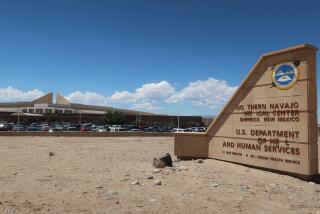Native Americans Attack Health Care Gap : Medicine: On the frontier, one physician was responsible for treating 30,000 people. Today, Indian Health Service works to improve care. Some modern reservation hospitals include traditional healers.
- Share via
Army doctors, trying to stop the spread of smallpox and other contagious diseases around frontier forts in the early 19th Century, started vaccinating Indians.
That was the first federal health service delivered to the tens of thousands of Native Americans. “But it was done to protect the soldiers, not the Indians,” said Patricia A. DeAsis, a Cherokee from Oklahoma, who is communications director at Indian Health Service headquarters in Washington, D.C.
When frontier doctor Albert M. Wigglesworth arrived at the Navajo reservation in the high desert of northeastern Arizona in 1904, there was no hospital, no nurse and virtually no medical equipment.
“I was the only physician for some 30,000 Indians on a reservation of 16 million acres--almost double the area of Connecticut and Massachusetts combined,” he wrote decades later in his memoirs.
Lame from an untreated childhood fracture, the young doctor wasn’t eligible for higher-paying military or U.S. Public Health Service posts. Only the Indian Service was open to him.
“Doc” Wigglesworth, housed on the reservation at old Ft. Defiance, would become the first white “medicine man” to responsibly serve the largest Native American tribe.
Ninety years later, the Indian Health Service is still fighting to improve the health of Native Americans and Alaska Natives, which continues to lag well behind that of the U.S. population.
Indian death rates for seven major causes are greater than those of the population as a whole: alcoholism, 438% greater; tuberculosis, 400%; diabetes mellitus, 155%; accidents, 131%; homicide, 57%; pneumonia and influenza, 32%; and suicide, 27%. Heart diseases and accidents are the two leading killers.
The federal comprehensive health care program, available to the 1.3 million natives belonging to the 547 federally recognized tribes, is provided by 1,100 doctors, 380 dentists, 2,600 nurses, 100 physician assistants and numerous allied health professionals. It operates 42 hospitals and 119 health centers and stations.
Proposed cuts in the $1.8-billion Indian Health Service budget were on the agenda last April when 300 tribal chiefs met with President Clinton, the first and largest gathering of Indian leaders at the White House.
In May, Sen. John McCain (R-Ariz.) introduced a bill that would elevate the Indian Health Service within the Department of Health and Human Services to a policy-making level equivalent to that of the Bureau of Indian Affairs in the Interior Department.
The Native Americans’ struggle with health problems is rooted in some of the decades-old diseases and in conflicts between traditional Indian healers and modern Western medicine about how to treat them. As a result, DeAsis said, in many communities a dual, and often confusing, health-care system persists.
Navajo medicine men, or “hatathli,” at first resented the intrusion of doctors like Wigglesworth.
Navajo children at that time were sent to schools off the reservation. “It was a terrible mistake,” Wigglesworth wrote, “for they began returning them dying of tuberculosis.
“I was frantic. I had no place to keep them. There is no idea of sanitation in the hogans (earthen Navajo dwellings) of their families. I had to stand by and see the infection planted. Now we were reaping the harvest. There had been very little TB on the reservation earlier. Now it was very common.”
Wigglesworth demonstrated the importance of sanitation. Even today, DeAsis said, “construction of sanitation facilities has done the most to save lives on the reservations.”
Wigglesworth opened the Navajos’ first federal hospital, a 60-bed frame building, and the first tuberculosis sanitarium, with 25 beds. He treated trachoma, a contagious eye infection that was prevalent among Navajos.
In 1909 the Public Health Service conducted a trachoma survey of Native Americans because of numerous reports of the unusually high incidence of blindness among them. It resulted in a U.S. handbook for trachoma control that has become a global reference.
During the 1918 flu epidemic, which killed more than a half-million Americans and 20 million people worldwide, Wigglesworth and his family fell ill. “I had worked day and night with dying Indians and it was bitter cold,” he wrote later. “I was anointed for death by one of the missionary priests.” Wigglesworth survived and lived to be 92.
While modern medicine helped improve the health of Native Americans, it diminished the influence of the traditional healer. Within the last two decades, DeAsis said, the Indian Health Service has tried to bridge this medical gap to enhance healing without interfering with newer treatments.
Among Indians, the circle of life--symbolizing birth, growth into adulthood, old age, passing on and rebirth--is sacred and understood across all tribes. It is an integral part of the Native American medicine wheel. Wellness is harmony and balance among mind, body, spirit and the natural environment.
In modern medicine, the focus is only on the physical, said J. T. Garrett, a Cherokee from North Carolina, who is a traditional healer and a director of health care administration at Indian Health Service headquarters.
“On my reservation and others, we have a place, a room, in our modern hospital for traditional healing,” Garrett said. “Our patient bill of rights says that you can consult a traditional medicine person and bring in paraphernalia--herbs, teas, crystals, feathers.” Traditional healers are regarded as “visiting doctors.”
Medicine men and elders of the Navajo Nation provided clues to a mysterious epidemic that plagued the Four Corners region of the Southwest last year. Rodents were suspected carriers. Pinyon trees had borne their sweet nut all year for only the third time this century, the Navajos said. Residents were warned to stay away from pinyon trees, frequented by rodents.
Eventually, the disease was identified as hantavirus and traced to deer mice.
Through the decades, the Indian Health Service has developed a recognized community-oriented public health care model. “Health officials from the Third World come to look at what we have,” DeAsis said.
More to Read
Sign up for Essential California
The most important California stories and recommendations in your inbox every morning.
You may occasionally receive promotional content from the Los Angeles Times.










